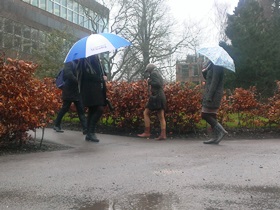Dr Emma Irvine is a post-doctoral research assistant in the Department of Meteorology at the University of Reading.
In January this year a new measure to tackle climate change came into force. Designed by the European Union, it targets the 220 million tonnes of CO2 emitted annually on flights departing from or arriving to a European airport (figure from 2006). The new measure is to include aviation CO2 emissions in the EU’s emissions trading scheme; the aim is to achieve real reductions in the CO2 emitted by this fast-growing industry. Put simply: the cost of a flight, for both airline and passenger, now includes CO2.
Why is there a need for such a scheme in the first place? In 2006, globally, aircraft emitted around 700 million tonnes of CO2 into the atmosphere, 30% of which was from flights originating or departing Europe. Putting this into context, global aviation contributed approximately 2% of man-made CO2 emissions (in that year).
This is a small proportion; the UK’s share of aviation CO2 emissions is much less than the contribution from, for example, heating our homes (14.8%) or generating electricity (about 26%). So, why all the fuss? First, the aviation industry is growing by around 5% per year, meaning that its share of CO2 emissions could rapidly increase. Second, the climate impact of aviation, a topic of research at the University of Reading, is not just from CO2 emissions. The non-CO2 climate effects of aviation, like water vapour, ozone creation and contrails, increase aviation’s total contribution to human-induced climate change to up to 15%.
The good news is that the aviation industry isn’t sticking its head in the sand. It has set its own stringent targets that new aircraft entering service in 2020 should produce 50% less CO2 (per passenger kilometre) than aircraft in 2000. The question is, left to its own devices, will the aviation industry really be able to make a significant dent in its CO2 emissions? The EU thinks not.
Now for the technical bit: the Emission Trading System (ETS) limits (‘caps’) overall CO2 emissions in Europe from certain industries; under this cap and trade scheme, companies buy carbon credits to cover their CO2 emissions up to the cap, and may trade surplus carbon credits on the carbon market. So how does this work for airlines? The total amount of CO2 that can be emitted by aviation is now capped at 97% of the annual average emitted in 2004-2006; this includes CO2 emissions from all flights which arrived at or departed from a European airport (i.e. it counts the total CO2 from the flight, not just the portion of the flight that was in European airspace). 85% of this cap is distributed to airlines as free allowances, proportional to that airline’s share of the emissions in 2010. The remaining 15% of the cap will be auctioned.
At the end of April 2013, each airline must surrender sufficient carbon credits to cover their 2012 CO2 emissions. Therefore if an airline wishes to expand its operations in Europe, it must either buy carbon credits at auction (or trade from other airlines who have reduced their emissions and thus have surplus credits) or from another industry sector. The implementation is fairly complicated but the rationale behind the scheme is simple: the less CO2 you emit, the smaller your costs, and in a competitive market this should effectively drive CO2emission reductions.
So far so good. But that’s not the end of the story. Internationally, the inclusion of aviation into the EU ETS has been highly controversial; the EU’s decision to introduce a regional scheme is seen by many as taking unilateral action that is both unfair and counterproductive. Legal action, brought by US airlines, was defeated by the European courts in December, however the US government may still make it illegal for US airlines to comply with this new EU law (interestingly, Delta has coincidentally introduced an unspecified $3 per passenger surcharge, ‘just in case’). China doesn’t want its airlines to pay, and has both suspended a large order of (the European-based) Airbus aircraft, and refused to allow its airlines to comply. UK airlines, with the noted exception of Ryanair, have been mostly supportive; BA has previously voluntarily participated in a UK-based ETS. It is expected that airlines will pass on the costs of participating in the ETS to its passengers in the form of surcharges. So far surcharges have been at the bottom end of the range of estimates of 2 Euros to 3% of the ticket price, and in any case will be insignificant compared to UK air passenger duty (currently £60 for a flight to New York).
It is unclear how this story will end. At a debate I attended at British Airways last December, the overwhelming majority agreed that market-based measures are the best way to tackle CO2 emissions, even if few people believed that the EU would manage to implement the aviation ETS without some concessions or modifications. Some concessions seem likely as international opposition to the scheme is not only increasing but becoming more organised: a coalition of countries (including the US, China, India and Russia) recently met to decide on ‘retaliatory action’ against the EU, threatening to escalate the situation into a full-scale trade war. Meanwhile, aviation’s governing body ICAO says it is accelerating efforts to design a global ETS-style measure for aviation and will present its proposals by summer (full story at http://www.greenaironline.com/news.php?viewStory=1417).
Even the EU acknowledges that a global solution is clearly the best way forward. The EU ETS could just be the catalyst to make that happen.




